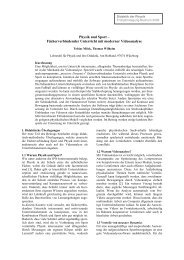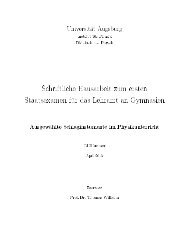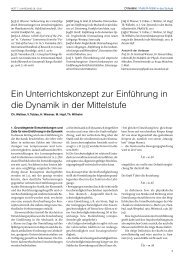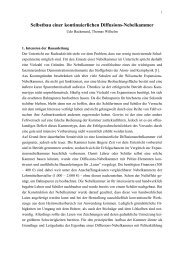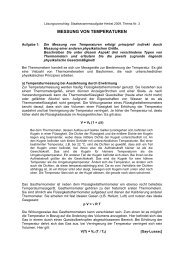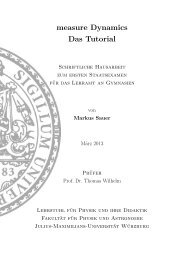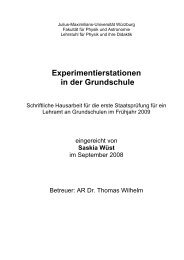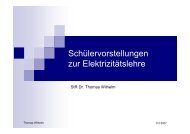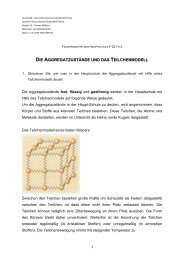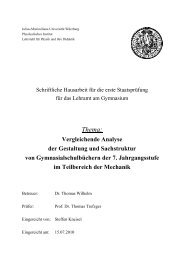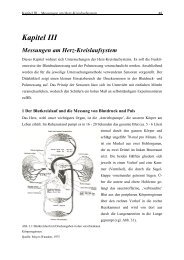Konzeption und Evaluation eines Kinematik/Dynamik-Lehrgangs zur ...
Konzeption und Evaluation eines Kinematik/Dynamik-Lehrgangs zur ...
Konzeption und Evaluation eines Kinematik/Dynamik-Lehrgangs zur ...
Sie wollen auch ein ePaper? Erhöhen Sie die Reichweite Ihrer Titel.
YUMPU macht aus Druck-PDFs automatisch weboptimierte ePaper, die Google liebt.
9 Abstract 267<br />
to a described motion, no significant difference could be proved (ntreat = 211, ncontr = 188) (chapter<br />
6.4.2.4). The fact that within this concept motions in one dimension were dealt with less than in<br />
traditional instruction, and instead <strong>und</strong>erstanding for quantities was trained using two-dimensional<br />
motions does therefore not influence the solution of these problems on motions in one dimension.<br />
Things are quite different when it comes to asking about the direction of acceleration instead of<br />
about the graph. In the case of tossing a coin vertically up into the air (with change of direction), the<br />
direction of acceleration in the form of algebraic signs with a given coordinate system and in the<br />
form of arrows was asked, so that the students had to make a decision between the conception of<br />
�<br />
“speeding up/slowing down” a = ∆ v / ∆t<br />
(acceleration as a change in speed) and a conception of<br />
� �<br />
direction a = ∆v<br />
/ ∆t<br />
. In this instance, the students of the treatment performed highly significantly<br />
better (ntreat = 151, ncontr = 188) (chapter 6.4.3.2): 39 % gave a correct answer combination referring<br />
to the algebraic sign, compared to 7 % in the control group. 42 % gave a correct answer combination<br />
with regards to the arrows, compared to 9 % in the control group. Arrows corresponding to<br />
velocity were given by only 27 % compared to 62 % in the control group.<br />
The treatment group also showed a more adequate conception of direction in test questions on acceleration<br />
in a two-dimensional motion. In this case, the students were only supposed to give the<br />
direction of acceleration as an arrow, whereas the change in speed was explained in words. In case<br />
of motions along a straight line, no great difference could be observed between treatment group and<br />
control group. With motions along a curved path, however, there were great and highly significant<br />
differences: 77 % of the tested students in the treatment group (ntreat = 35) gave a correct answer on<br />
average, as opposed to only 9 % of the control group (ncontr = 217), resulting in an effect size of d =<br />
2.95 (chapter 6.4.1.2).<br />
Thus the conclusion is drawn that in those classes taught according to this teaching concept, more<br />
students have gained a physically adequate conception of acceleration and have an idea of the direction<br />
of acceleration. This advantage, however, is of no use to them if it comes to interpreting graphs<br />
in motions in one dimension.<br />
In order to test the <strong>und</strong>erstanding of Newton’s First and Second Law, problems on motions in one<br />
dimension were used. With problems regarding force, where the answer options were given as texts,<br />
significantly more students, namely 39 % (ntreat = 188), than in the control group (32 %) (ncontr =<br />
211) answered corresponding with the Newtonian conception (chapter 6.5.2.3). Significantly more<br />
students, namely 34 %, than in the control group (21 %) answered problems, where the answer options<br />
were given as time-force graphs, corresponding to the Newtonian conception (chapter 6.5.2.3).<br />
At any rate, with 0.20 and 0.34, respectively, the effect sizes are only weak to medium.<br />
The established FCI test, in which more aspects of the force concept in more variable contexts were<br />
tested with qualitative problems only, yielded a clearly different result. In the post-test, 53 % of the<br />
items were answered correctly (ntreat = 138), in contrast to only 41 % in the traditionally taught control<br />
group (ncontr = 258). This is a significant difference (0.001 scale) with a relatively big effect size<br />
of d = 0.77 (chapter 6.5.1.3). With 31 %, the normalized gain of the students is also significantly<br />
higher (0.001 scale) than in the control group with 18 % (effect size 0.66). The proportion of stu-




